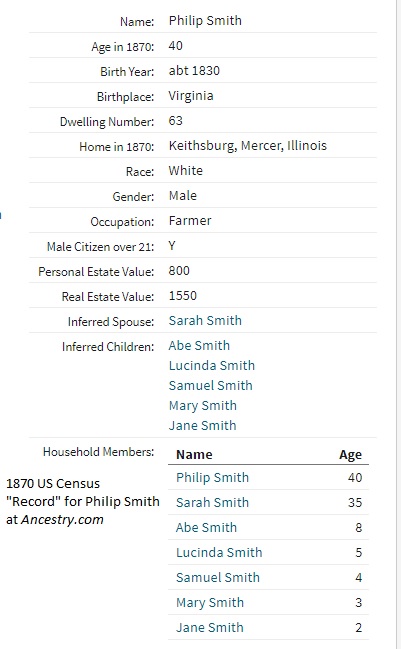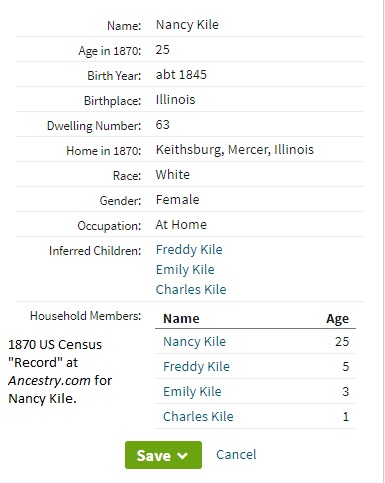It’s the automation of the research process that can create confusion. If records were completely standardized, families always lived in the same structure, and no one “colored outside the lines,” research would be easier.
But they didn’t color in the lines all the time.
Records are not always standardized.
Families can live in more than one structure.
The 1870 US Census index at Ancestry.com attempts to suggest “household structure.” Sometimes it works and sometimes it doesn’t. The difficulty comes into play when people use Ancestry.com‘s interpretation to automatically complete their own family trees. Some of these problems would be solved if people would read the actual record and enter family structure and relationships after reading and analyzing the actual record.
The household hold headed by Philip Smith in Keithsburg Township, Mercer County, Illinois, in 1870 includes individuals with the last name of Smith and Kile. It’s clear from the actual enumeration that it is one household–since the dwelling and family number for the Smith/Kile household are clearly 63 and 65 and the next entry for John McDonald is numbered 64 and 66.

Yet the Ancestry.com 1870 US Census breaks the entry up into two households–one for Philip Smith and one for Nancy Kile. It even infers children for both “households.”
Referring to the individuals as “household members” is correct. What is interesting is that Ancestry.com has the dwelling numbers correct for these people, but apparently added some other field in their own internal database that separated these individuals into “households.” Otherwise, how would their servers know how to spit back that data to me in that format?
I really don’t like them adding information to the census that’s not there.
But are those Nancy’s children? Or are they her younger siblings? Or are they some of each? Ancestry.com doesn’t know just on the basis of that census enumeration.

What appears to be happening here is that:
- Ancestry.com “adds” some field so that it can display households that are different from the household as enumerated in the census
- Ancestry.com infers children based upon the census entry
We’ll have to see if other census years at Ancestry.com perform similar “analysis” to what their 1870 “index entries” do.

3 Responses
ancestry does a lot of stupid stuff. No doubt because no one there actually does genealogy, they invest money in a company that makes money. I think at the rate MyHeritage is going, they are going to take over and ancestry won’t have a clue what happened. Give them 5 years. Ancestry will still get the people who don’t know whether they need to buy a kilt or lederhosen but the real researchers will abandon them.
While Ancestry certainly has their issues, if one uses it for access to images of records and remains aware of the limitations, it serves a purpose. Although as other providers include the same materials in their databases, that may change.
I like Ancestry because it has a lot of records that are easy to integrate and they index pretty well plus they integrate soundex. You still have to look at the digitized documents. Some aren’t digitized, just indexed, and less useful. I find Fold3 tedious to use and I think Ancestry owns them. But I augment with many online sources. If I’m searching on Ancestry in West Virginia where there are many indexed records and truncated dates, I’ll have West Virginias vital records open in another window. Its easier to find on Ancestry then go to West Virginia’s website to see the document itself.i love the State provided sources but if you don’t have exact spellings of names it can be time consuming. Ancestry is my repository but hardly my only source. I helped a lady locate the living descendants (great great grandchildren) of a lady whose Bible was dated 1863. Ancestry did fine for most of the work but the actual contact was made through Facebook. The Bible is back with the family now. No one source is ever enough.